How One Electrician Invented a Tool to Survive the Australian Sun: Trade Shade
As an electrician, the weather can be your biggest enemy. That’s why we sat down with Sean Conneely, the electrician-turned-inventor behind the Trade Shade, a magnetic umbrella holder designed to keep electricians and other tradies cool, dry, and protected on the job. What started as a DIY solution for brutal Australian sun has become one of the most talked-about jobsite accessories out there. In this interview, Sean shares the ups and downs of inventing the Trade Shade, what it took to get it off the ground, and the lessons he’s learned along the way. If you’re an electrician with your own tool idea or just want to know how your favorite tools get made, this one’s worth a read.
Beating the Heat: How Trade Shade Got Started
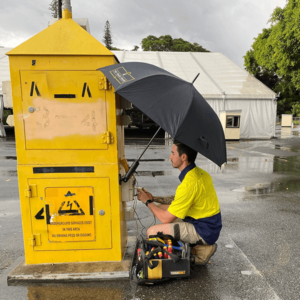 Rack-A-Tiers: Most inventions people bring to us were created because someone wanted to solve a common, annoying problem. Where did the idea for Trade Shade come from?
Rack-A-Tiers: Most inventions people bring to us were created because someone wanted to solve a common, annoying problem. Where did the idea for Trade Shade come from?
Sean: I’m Sean, I’m the founder of Trade Shade, a magnetic umbrella holder designed for tradies to keep out of the sun and the rain. I started my journey as an electrician in 2013 when I left school and became a sparky. I did my apprenticeship in North Queensland, and we were doing a lot of residential work outside, like switchboards and air cons, and I was just sick of getting sunburned, to be honest.
We were using tarps or zip-tying umbrellas to try to keep out of the sun, because it’s very hot here in Queensland. If you do switchboard upgrades, you spend three or four hours in the sun, and there’s no escape from it here in Australia. Then one day, I was like, surely there’s something out there for this, and there wasn’t. I made a little prototype in the garage of my apartment and started from there.
From Idea to Jobsite: Building the First Prototype
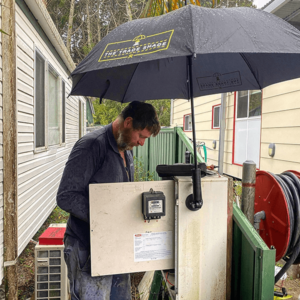 Rack-A-Tiers: How do you go from identifying the problem to working on a prototype? What motivated you and pushed you to take that next step? Many people have ideas, but don’t move forward with them.
Rack-A-Tiers: How do you go from identifying the problem to working on a prototype? What motivated you and pushed you to take that next step? Many people have ideas, but don’t move forward with them.
Sean: I suppose I got it from my dad. He’s a mechanic, and if he needed a specific tool that was bent a certain way, he would make it himself, so maybe that’s where it came from.
It was just something that naturally happened. I went to Bunnings, our local hardware store, and got some steel tubing and steel metal and whipped something up so I could see if the idea worked. It took a lot of iterations to get it to something that we could use on-site. For example, the magnets I thought would work were really small, and I didn’t realize how much leverage the umbrella would pull against the magnet, which caused huge issues for the first few models. I realized I need a giant magnet to hold these things on the switchboards, no matter what angle you move the umbrella to.
 Rack-A-Tiers: Did you ever feel doubt during this process, like it wasn’t working out and might never be finished?
Rack-A-Tiers: Did you ever feel doubt during this process, like it wasn’t working out and might never be finished?
Sean: There were definitely sometimes when things were just not going right, especially in the prototyping phase. I came from a trade background, so I knew how to build stuff with my hands, but I had no idea on the process of manufacturing or how to build something from scratch and how to make sure the engineering works before you actually go into manufacturing.
There was a lot I had to learn, and there wasn’t really anyone I could ask for help who had done something like this. It was just a lot of YouTube and stuff online. 3D printing wasn’t as big back then as it is now, so it was really hard to find someone to prototype. You had to make it out of steel or metal and do all these little refinements yourself before you could put those changes into the CAD file and then send it off to get them all done.
There were plenty of times when I thought it was not working out. I remember we launched without packaging inserts because I completely overlooked the fact that I needed something to hold the product in the box. I thought I could put the product in the box. So, there was plenty of stuff that went wrong, but there was never a point where I was going to give up. It was kind of like, I’ve started this, I’m going to finish it.
The feedback I got from showing the prototype, even though it was very caveman style, was that people thought it was a great idea, and I knew I had people who wanted to buy it when I was ready to launch. That’s what kept me going.
Built for Sparkies, Handy for Everyone
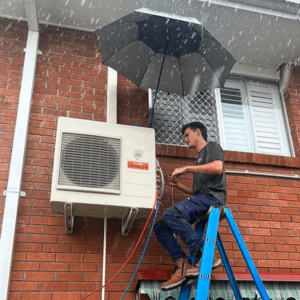 Rack-A-Tiers: What would you have done differently now that you have more experience?
Rack-A-Tiers: What would you have done differently now that you have more experience?
Sean: In hindsight now, and with the other products we developed, the one thing I tried to think about is how someone else would use this product. How is the construction of the product going to affect them?
With the Trade Shade, it was built for me and built for sparkies, but since then, we’ve got so many other trades using the product. We’ve got plumbers using them on hot water systems, we’ve got stump grinders, HVAC techs, and more. There’s all this stuff that the product wasn’t really designed for, but people are using it for, so we’ve had to make sure it works for everyone.
The Best Part of Inventing Tools
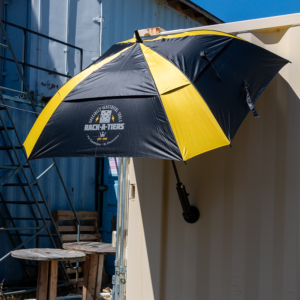 Rack-A-Tiers: Since starting this journey, what have been the key moments that you celebrated as major milestones?
Rack-A-Tiers: Since starting this journey, what have been the key moments that you celebrated as major milestones?
Sean: The launch day was a really big moment for me because there were ten months of super hard work building up to that. I was still working full-time, and I was doing this on the side. Every night I was working till 3 a.m. and then getting up for work at 5 a.m. and going on to work all day, and just doing that over and over again.
The first stockist was also a really big moment for me because I was like Wow, they approached me and wanted to stock the product. I had no idea about wholesale or pricing, or anything like that. It was all new, but it was like such a big milestone to have them displayed in a store. I could go in and see that there were two fewer than there were yesterday, and it was a really good feeling going in there during the week and seeing the stock go down.
Another big one was when my mum said one of her friends at work was talking about this product her husband had and how good it was, and she had no idea that it was her son’s product that they were talking about. I used to always tell people in a pub that I was a sparky because it was easier, but now, I can say I’m the guy who made the Trade Shade, and if they’re a tradie, they usually know what it is. It makes me feel proud of what I’ve built and all the hearts we put into it.
Rack-A-Tiers: That’s so awesome, definitely something to be proud of.
Beat the August Heat with Trade Shade
How Electrical Tools Really Get Made
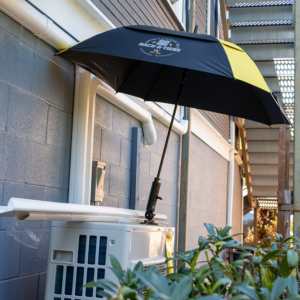 Rack-A-Tiers: I’m going to shift gears a little bit. What kind of advice would you give to people who have invention ideas?
Rack-A-Tiers: I’m going to shift gears a little bit. What kind of advice would you give to people who have invention ideas?
Sean: Best advice is just start, just do it, just start with something. People still have this mentality that creating something, a product, especially a mass-manufactured product, where you’re injection molding and you’re turning raw materials into an actual physical product, is this massive, big thing that’s super complicated and only for the big guys like Milwaukee and Makita. But it’s not. It’s never been more accessible to the everyday guy, and you have so much at your fingertips to do it.
Take little baby steps. Start with the drawing, then a CAD file, and then make a prototype. You don’t even have to 3D print one if you don’t want. You can just make one out of metal or timber or anything you can find. Just make a start, and then the momentum is what keeps you going. Once you start and do one thing, then you do the next thing, and then all of a sudden, you’re at the launch. It’s not as scary as it seems.
There are lots of people who are willing to help you. What’s good for the industry is good for everyone. There’s plenty of help and there’s plenty of information out there, you just have to get a start on it and make an effort to take those baby steps.
Everyone Wants a Trade Shade
 Rack-A-Tiers: Do you have any funny stories from making the Trade Shade that we could share with our followers?
Rack-A-Tiers: Do you have any funny stories from making the Trade Shade that we could share with our followers?
Sean: We were running out of stock a lot in the first two years. We ran out of stock five or six times in the first year and a little bit less than that afterwards. The trickle-down effect of that was people were having their Trade Shades stolen at work, so it became such a stolen item that customers would message me all the time going, “I went out to lunch and had this sitting on a switchboard and someone’s just come and stolen it.” I don’t know if people stealing them was a direct cause of us selling out, but it became a hugely stolen item for tradies for a while there.
Rack-A-Tiers: Sounds like people really want a Trade Shade. I think it’s a great bit of marketing, honestly!
Sean: Yeah, maybe we can use it in some ads: the “most stolen” tool or something.
Desert Island Tools: What Every Sparky Needs
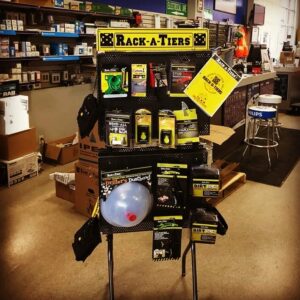 Rack-A-Tiers: Alright, a bit of a fun one. If you were stranded on a desert island and as an electrician, you’ve only got three tools that you can use, what would they be?
Rack-A-Tiers: Alright, a bit of a fun one. If you were stranded on a desert island and as an electrician, you’ve only got three tools that you can use, what would they be?
Sean: My Trade Shade.
Rack-A-Tiers: Of course.
Sean: Oh, you put me on the spot here.
Rack-A-Tiers: Take your time!
Sean: My Esky with my lunch in it, can we count that?
Rack-A-Tiers: Yeah, 100%. But for people in North America, you’ll have to tell them what an Esky is.
Sean: Yeah, what do you guys call it? Oh, a cooler! Ok, and I will also go with my Channellock pliers. I’ll keep it easy.
Why Working with Your Hands Beats a Desk Job
 Rack-A-Tiers: What do you think, in your time working as an electrician, was the best thing about being a tradie?
Rack-A-Tiers: What do you think, in your time working as an electrician, was the best thing about being a tradie?
Sean: My favorite thing about being an electrician, especially now since I spend a lot of time in an office or behind a laptop, is being out at a new place every day and working with my hands. It was by far my favorite thing. You meet a lot of new people doing residential work and moving between jobs in different people’s houses. You meet a lot of good people, you’re out there working with your hands, and you’re working outside. You literally can’t beat it.
You’re Not Tougher Than the Sun
 Rack-A-Tiers: Okay, I’ve got one more and then we can wrap it up. At Rack-A-Tiers, we sell a lot of tools that make the job faster, better, safer, and more efficient. A lot of people see these tools and say you’re “soft hands” or just aren’t tough enough. What would you say to people who have that attitude, considering Trade Shade not only helps with the heat and rain but also helps prevent skin cancer?
Rack-A-Tiers: Okay, I’ve got one more and then we can wrap it up. At Rack-A-Tiers, we sell a lot of tools that make the job faster, better, safer, and more efficient. A lot of people see these tools and say you’re “soft hands” or just aren’t tough enough. What would you say to people who have that attitude, considering Trade Shade not only helps with the heat and rain but also helps prevent skin cancer?
Sean: Here in Australia, skin cancer is the biggest cancer we have, and it’s also the most preventable cancer. It makes zero sense to get on there and go, Oh, back in my day, we used to do this, or we were tougher. The guys who were drilling the holes with hand tools back in the day were saying the same thing when electric tools came out. It’s just the progression of how things go, and why wouldn’t you want to make your work life easier or faster or include less effort?
It doesn’t take away from the fact that you’re doing a quality job or anything like that. It just means that you’re more comfortable at work, your job gets done quicker, and it’s easier on the body. With everything in life, time moves forward, and better ways of doing things come out. If you don’t move with the times, you get stuck then left behind. That’s how it’s always been.
Rack-A-Tiers: Things get easier and better over time, and it improves your work and life. That’s what everyone’s going to work for. That’s what they’re working their ridiculous hours for.
Sean: That’s exactly right. That’s what everyone’s striving for, right?
Protect Yourself From the Sun with Trade Shade
Made By Electricians, For Electricians
Big thanks to Sean for taking the time to share his story. From getting roasted under the Queensland sun to building one of the most practical jobsite tools we’ve ever seen. The Trade Shade isn’t just about comfort, it’s about protecting electricians from harsh sun and rain, while making long outdoor jobs more bearable (and a lot safer). It’s simple, smart, and built tough for the kind of conditions electricians face every day. If you haven’t checked it out yet, now’s the time.